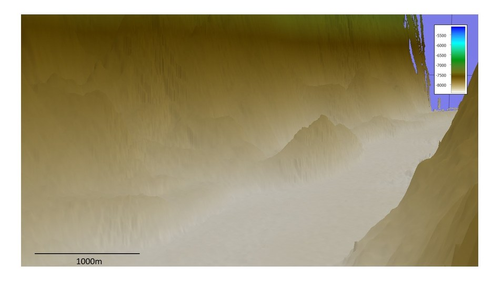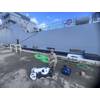Sonar Assists Deepest Solo Sub Dive

The Kongsberg Maritime EM 124 1x2" mapped the Puerto Rico Trench to depths greater than 8,000 meters. (Photo: Kongsberg Maritime)
In December 2018, Victor Vescovo became the first person to reach the deepest part of the Atlantic, piloting his private submersible the Limiting Factor 8,376 meters below the ocean's surface to the bottom of the Puerto Rico Trench -- the deepest solo human submersible dive ever.
It goes without saying that state-of-the-art subsea technology was key to the mission's success. The submersible, a Triton 36000/2, features a 90mm thick pressure hull and is the first commercially certified full ocean depth.
New multibeam sonar technology from Kongsberg Maritime also played a big part in the feat. Utilized for precision mapping, the Kongsberg EM 124 was installed aboard the DSSV Pressure Drop to produce seafloor bathymetry to map the trench.
"[The EM 124] produced digital 3D renderings of the sea floor that were used to identify and verify the deepest point in the trench that ultimately determined the dive location," Vescovo said. "This was essential to the success of the mission."
The EM 124, released in 2018, is the fifth generation of a range of new multibeam systems from Kongsberg Maritime and is the successor of the EM 122.
"This was the very first delivery of the EM 124, and [it] has already proven to be a success with fantastic results," said Chris Hancock, vice president of sales for Kongsberg Underwater Technology. "Our expert technical team was able to optimize system performance and conclude successful sea acceptance trials just prior to the scheduled dive in the Puerto Rico Trench."
EM 124 is a modular, state-of-the-art multibeam echosounder that performs high resolution seabed mapping from shallow waters to full ocean depths (11,000 m) with unparalleled swath coverage and resolution. Its broad range of functionality includes the simultaneous collection of seabed and water column imagery, which saves time and increases efficiency during the planning, execution and analysis phase of a mission. The low-noise electronics are compact and flexible in design for easy installation and integration into a vessel of any size.
"The EM 124 is arguably the most advanced underwater sonar currently installed on a civilian vessel," Vescovo said
The record dive is part of the Five Deeps Expedition, which seeks to reach the deepest points in the five oceans in a commercially-certified manned submersible by the end of 2019. The journey will cover 40,000 nautical miles, and by the end, the submersible will have descended through at least 72,000 meters of water.
After the 8,648 meter dive to the bottom of the Puerto Rico Trench, the mission will head to the South Sandwich Trench (Southern Ocean 8,428 meters), Java Trench (Indian Ocean 7,725 meters), Mariana Trench/Challenger Deep (Pacific Ocean 10,898 meters) and Malloy Deep (Arctic Ocean 5,669 meters).
Hancock said Kongsberg will remain involved with the mission throughout. "Over the next 12 months, we will continue to work together and support the expedition remotely through our Mapping Cloud service," he said.














 December 2025
December 2025



